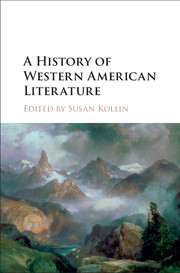Book contents
- Frontmatter
- Contents
- Notes on Contributors
- Acknowledgments
- Introduction: Historicizing the American Literary West
- PART I HOMELANDS
- PART II MAKING A REGION
- 3 Domestic Frontiers: Settler Narratives by European American Women Writers
- 4 Labor and the Land: Narratives of Trading, Mining, and Ranching
- 5 Nature Writing and the American West
- 6 Tall Tales and Short Stories
- 7 The Popular Western
- PART III GEOGRAPHIES OF THE LITERARY WEST
- PART IV THE TWENTIETH CENTURY AND BEYOND: LITERARY MOVEMENTS AND CRITICAL PERSPECTIVES
- Selected Bibliography
- Index
7 - The Popular Western
from PART II - MAKING A REGION
Published online by Cambridge University Press: 05 November 2015
- Frontmatter
- Contents
- Notes on Contributors
- Acknowledgments
- Introduction: Historicizing the American Literary West
- PART I HOMELANDS
- PART II MAKING A REGION
- 3 Domestic Frontiers: Settler Narratives by European American Women Writers
- 4 Labor and the Land: Narratives of Trading, Mining, and Ranching
- 5 Nature Writing and the American West
- 6 Tall Tales and Short Stories
- 7 The Popular Western
- PART III GEOGRAPHIES OF THE LITERARY WEST
- PART IV THE TWENTIETH CENTURY AND BEYOND: LITERARY MOVEMENTS AND CRITICAL PERSPECTIVES
- Selected Bibliography
- Index
Summary
The western genre is named after a geographic location – the American West – but despite its misleading geographic specificity, the western is a global genre. A genre that emerges in the nineteenth century, the western has persisted and changed throughout the twentieth and twenty-first centuries. Indeed, while the popular western originates in prose fiction, the genre is remarkable for its adaptability. A major category of popular and classic American literature, the western has also thrived in theater, film, television, radio, comic books, video games, music, and visual art, both in the United States and beyond. The versatility of the western can also be tracked in the variants of the genre that have sprung up over the decades. For example, one of the top-grossing western films of all time is a parody of the genre, Mel Brooks's Blazing Saddles (1974), and western tropes have been parodied, satirized, subverted, magnified, and adapted in a variety of ways, from Joss Whedon's sci-fi western TV series Firefly (2002) and Rockstar Games's combination of the western and the zombie narrative in Red Dead Redemption: Undead Nightmare (2010) to Ishmael Reed's rapacious, postmodern western novel Yellow Back Radio Broke-Down (1969) and Kelly Reichardt's open-ended, meditative western film Meek's Cutoff (2010). The popular western is a generic formula, but one that has been rendered in multiple aesthetic and social modes.
The western consists of a cluster of recognizable tropes: the shootout, the open landscape of the American frontier, the clash between rustlers and ranchers, the noble outlaw, the madam with a heart of gold, the saloon brawl, the vanishing Indian, the innocent homesteader, the tenderfoot, and so on. The genre's elements often coalesce into a story of good versus evil, the white hat versus the black hat, though the actual historical, geographic, and political coordinates of “good” and “evil” vary widely in the popular western. For example, as Christine Bold has argued, some of the most celebrated westerns in the early twentieth century heroized cowboys and mercenaries who murdered innocent homesteaders and farmhands during the 1892 Johnson County War in Wyoming.
- Type
- Chapter
- Information
- A History of Western American Literature , pp. 111 - 126Publisher: Cambridge University PressPrint publication year: 2015

